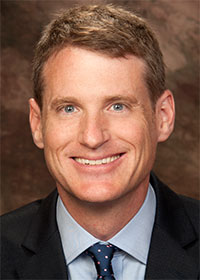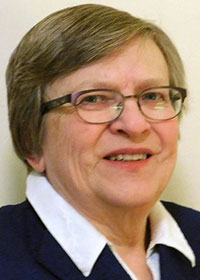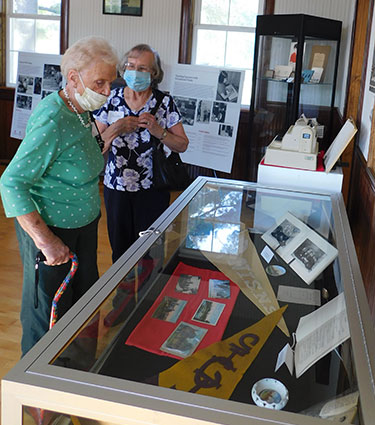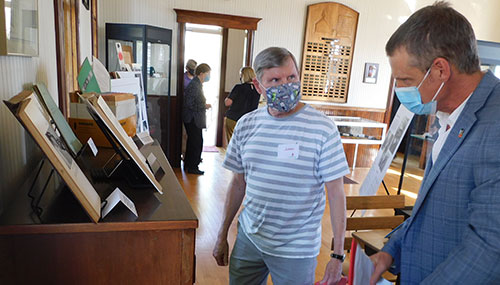
Born in 1932, Jim Johnson grew up in the tiny village of Ellsworth, Wis., about an hour southeast of Minneapolis.
His education – like that of his wife, Colleen, who grew up in nearby River Falls – began in a one-room schoolhouse.
“I enjoyed it immensely, and I suppose it connected with me in some way,” Johnson said Sept. 29 as he sat outside NIU’s own Milan Township One Room Schoolhouse. “The teachers were good, and it was fun to be with kids of different ages.”
Johnson was among a group of alumni, retirees and supporters of the NIU College of Education who attended the VIP unveiling of “A Worthy Calling: 125+ Years of Preparing Teachers.”
“We’re really excited to be able to honor that tradition and to learn about the changes that have taken place,” Dean Laurie Elish-Piper told the visitors before they toured the exhibition. “Our hope is that maybe you can reflect on some of the changes you experienced and help us to fill in the story.”
For more than three decades of the period between the Northern Illinois State Normal School’s chartering in 1899 to now, Johnson was part of that mission: He joined NIU in 1965 to teach Foundations of Education and to supervise a few student-teachers, a responsibility that eventually grew to leading the Department of Student Teaching.
“Twelve of us were hired that year because enrollment was sky-high,” Johnson said. “I really liked working with college-age students. They were eager to learn and sincerely interested in becoming teachers.”
So were the “pioneers” of the first graduating class of 1900, said Patrick Roberts, faculty director of NIU’s Blackwell History of Education Museum.

Roberts, who researched and curated the exhibition that explores the evolution of education throughout the United States and locally at NIU, spoke to the VIP group about the early days of preparing teachers in DeKalb and how that long-ago commitment has driven faculty since.
“We prepare people to care for the intellectual, social, physical and emotional well-being of other people’s children,” said Roberts, an associate professor in the NIU Department of Leadership, Educational Psychology and Foundations.
“Sometimes, those children don’t look anything like us. They don’t share a common background with us. Sometimes, they don’t even speak our language. Often, they don’t think the way we do,” he added. “And yet we set about the task of rising to the challenge of that great calling and preparing teachers to teach all students. That’s really a profound undertaking.”
Coming as the world continues to navigate the uncertainties of COVID-19, the exhibition exposes relevant ties to history.
“During the Spanish Flu of 1918, some of these same issues came up. ‘Should we shut the schools down?’ They did not,” Roberts said. “Chicago chose not to; they developed a very sophisticated way of monitoring and testing the students. They put school nurses in all the schools, and also sponsored a lot of outside activities. It’s really interesting, this contrast between the past and the present.”
Pam Farris, who joined the College of Education faculty in 1980 and attended the Sept. 29 event, sees such a contrast in the numbers of students pursuing careers as teachers.
Farris thinks back to her own first-grade class in Cory, Ind., where she was one of only three girls and six boys. Of that trio of females, one became a nurse, one became a secretary and one – Farris – became a teacher.

Now, she said, young women envision far more opportunities in their adult lives along with encouragement to pursue jobs in the STEM (Science, Technology, Engineering, Math) fields.
“I got into teaching kind of by accident,” said Farris, who knew from the age of 10 that she wanted to become a college professor.
“As a senior in high school, I started helping a first-grade teacher – a first-year teacher – who had more than she could handle and many children who were struggling readers, students who hadn’t had a lot of experience with print,” she added. “At that point, she just needed an extra pair of hands.”
She eventually taught elementary school while completing her master’s and doctoral degrees at Indiana State University focused on language arts and methods for teaching reading.
Literacy is integral to learning every subject, she said: “It’s so important to begin that basis of reading and writing in the K-8 years.”
Teaching at NIU was “very exciting,” added Farris, who in 1995 was named a Presidential Teaching Professor and continued to teach at NIU as an adjunct after her 2006 retirement.
“I enjoyed the enthusiasm of the undergraduates; they’re going to go out and conquer the world,” she said. “They’re so excited about their own creativity and looking at different ways to introduce material so that their students can engage in the learning process.”
Her own creativity includes “Crossover Dribble,” a novel she published in 2007 after she noticed how her own son was learning to read through baseball cards, and a textbook: “Elementary and Middle School Social Studies: An Interdisciplinary, Multicultural Approach.”

Johnson also scripted a legacy in textbooks.
Although he had hoped to become an oral surgeon following the Korean War, where he served as a dental technician in the U.S. Navy, he realized that the two years to complete his unfinished bachelor’s degree in biology and chemistry at the University of Wisconsin-River Falls and the seven years of professional school combined for a long time.
“By that time,” he said, “I’m not a kid!”
So, despite admittance to the University of Minnesota’s dental school, he decided to become a middle school science teacher. After three years, however, he returned to college, first in St. Cloud, Minn., and later at the University of North Dakota.
When he arrived in DeKalb, “I wasn’t really happy with the textbook I was told I could use. I decided I should write a textbook that was better.”
Enlisting the help of three colleagues – “new profs I got to know and became good friend with who had come at the same time and do the same thing: teach Foundations of Ed” – he did just that.
“We got very, very lucky,” Johnson said. “A major publisher was interested in publishing our book, and much to our surprise, it became a very big-selling textbook – and, rather quickly, it became the No. 1-selling textbook in that field in America.”
The youngest of the quartet of co-authors, he remained a constant in the updates as his colleagues retired or passed away. “Foundations of American Education: Becoming Effective Teachers in Challenging Times” is now in its 17th edition – and still selling well.
Johnson is proud of that legacy.

“Altogether, if you count revisions, I had a hand in publishing 30-some textbooks,” he said, “and all aimed at helping new teachers to learn about becoming teachers.”
He’s also proud of his legacy in the NIU College of Education, where he became assistant director of Student Teaching in the late 1960s and later took over when it became a department.
“Fortunately, I had three secretaries and three helpers, because student-teaching was a big, big thing. We graduated maybe 6,000 teachers, and some of those had been allowed to start teaching without a degree because there was such a shortage. It took a couple years to get certified, and we had to run big student-teaching program in the summer for people like that,” he said.
“As time passed, and the college reorganized, my title changed to director of Clinical Education and Student Services,” he added. “We had a staff of 20 or 30 people – advisers, recruiters, testing services, student-teaching supervisors – and that’s the job I had when I retired.”

